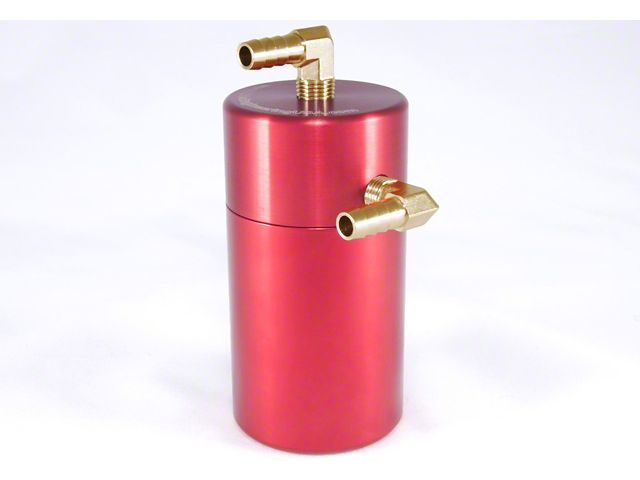

-

Add Details
- Change Vehicle
- Sierra 1500 Builds Gallery
Find Oil Catch Cans for your Sierra 1500
Red Standard Oil Catch Can; Brass Fittings/Rubber Hoses (14-25 V8 Sierra 1500)Find parts that fit my vehicle
Item S541767
Sierra 1500 Sales Tech
Verify parts fit & get product recommendations
M-F 8:30A-11P, Sat-Sun 8:30A-9P
Saved - View your saved items
We're sorry. We couldn't save this product at this time.
or use
Product Information
Description, Q&A
Description
Description. This is the PCV Catch Can that everyone is talking about!
Do it once, and do it right!
Elite Engineering Catch Can: Often Imitated, but never Duplicated!
The #1 choice for Automotive Tuners and featured in the Sept. 2009 issue of Corvette Fever magazine
Purpose of your Stock PCV System:
The PCV (Positive Crankcase Ventilation) system is designed to regulate and remove fumes from the engine crankcase, and to alleviate crankcase pressure which could cause oil leaks or seal damage. The PCV system routes crankcase fumes into the intake manifold where they can be burned to eliminate harmful emissions into the atmosphere. The PCV valve controls the amount of crankcase flow volume depending on the engine's load. With large throttle openings (high engine loads), the more blow-by gases are produced, and the more the PCV system flows oil vapor in to the intake manifold. A small amount of that ignited mixture leaks past the piston rings and ends up in the crakcase. This leakage is often reffered to a "blow-by" or leakage past the pistons. Some of the oil mist and other products settle along the engine intake and over time form a "gunk". Our oil catch can collects the oil mist and condensed the fuel vapors while allowing "cleaner" gasses to pass back into the intake manifold.
Negative Effects of your Stock PCV System:
Many Corvette, Camaro, Firebird and GTO owners can testify to the amount of oil residue that can accumulate inside the intake manifold, throttle body, intake track and even the air filter during aggressive driving conditions.
There are various negative effects when excess oil vapor contaminates the intake system from the stock PCV system - such as:
Throttle body and/or MAFS (Mass Air Flow Sensor) malfunction or failure.
Air filter, intercooler (if equipped) and intake ducting contamination if oil pools and run back out the intake system after engine shutdown.
Reduced octane of the air/fuel mixture, which can cause detonation and the ECM (Engine Control Module) to retard timing, thereby reducing engine power.
Excessive carbon build-up on valves, piston crowns, combustion chambers and spark plugs. This also increases the chance of detonation and power loss.
Increased emissions & possible contamination of catalytic converters and oxygen sensors.
Bottom line: Excessive amounts of oil vapor in the intake manifold is detrimental to your engine!
Solution: Install theElite Engineering PCV Oil Catch Can!
Ultimate Function:
Elite Engineering's PCV Oil Catch Can has a unique 3-chamber design to effectively separate oil from the crankcase vapors, thereby eliminating all negative effects of excessive intake system oil contamination. Oil vapor from the crankcase enters the 1st - Inlet/Filtration chamber where it is slowed down and caught in the stainless steel mesh, it then moves onto the 2nd - Transition/Diffusion chamber. The Diffusion chamber has a very specific set of holes to remove the oil and only let clean air vapor pass. Lastly, the vapor passes into the 3rd - Exit Chamber before it exits the Catch Can.
Not all Catch Cans are created equally! Often imitated, never duplicated. Most Catch Cans on the market are just comprised of an empty container with 2 ports. While that simple design may trap a few oil droplets, our Catch Can is designed to condense the oil vapor and trap the oil inside the container.
Our test proven design incorporates a stainless steel mesh and screening mechanism that acts like a maze to collect and condense the oil vapor. Once the oil vapors condense into liquid droplets, it falls to the bottom of the can. In addition, the top assembly is specially designed to keep any liquid from climbing out the exit hole during aggressive driving conditions. Stored oil volume is approximately 8 ounces. You will be amazed by how much oil our Ca
Fitment:
- 2014 GMC Sierra 1500
- 2015 GMC Sierra 1500
- 2016 GMC Sierra 1500
- 2017 GMC Sierra 1500
- 2018 GMC Sierra 1500
- 2019 GMC Sierra 1500
- 2020 GMC Sierra 1500
- 2021 GMC Sierra 1500
- 2022 GMC Sierra 1500
- 2023 GMC Sierra 1500
- 2024 GMC Sierra 1500
- 2025 GMC Sierra 1500
CA Residents: 
Reviews of similar Engine Products (1)
May 13, 2023
Review shared from Clear/Silver Standard Oil Catch Can; Black AN Fittings/Clear/Silver Braided Hoses (14-25 V8 Silverado 1500)
Oil separator
Easy to install, looks great! I haven't had it installed long enough to see how effective it is. But will follow up after 1,000 miles
Questions & Answers
Will It Fit My Sierra 1500
- 5.3L V8 - 14, 15, 16, 17, 18, 19, 20, 21, 22, 23, 24, 25
- 6.2L V8 - 14, 15, 16, 17, 18, 19, 20, 21, 22, 23, 24, 25




